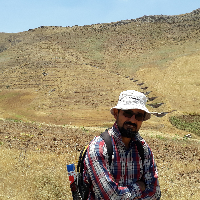Investigating the spatial distribution pattern of Nebaka, case study: Sufikam plain, Golestan province, Iran
Author(s):
Article Type:
Research/Original Article (دارای رتبه معتبر)
Abstract:
Introduction
Nebakas are single dunes formed by the accumulation of aeolian sediments under the bushes and shrubs. They play an essential role in the stability of arid and hyper-arid ecosystems, mostly by preserving the vegetation. Moreover, they are very important in stabilization of moving sand in deserts and semi-arid areas, as well as in protecting human settlements and facilities from sand infestation. The spatial point pattern analysis of natural or manmade effects provides useful information about the effects of competition between environmental conditions. The spatial point pattern of every phenomenon and their impacts on environment is being considered as a basic criterion for decision making, especially in risk management. For instance, spatial pattern of plants is a context in ecological theory, and a data-set consisting of a series of mapped point locations is a main example of a spatial point pattern. The methods for quantifying these characteristics of point pattern are known as summary statistics. From a statistical point of view, the methods are also appropriate for phenomena that represent various types of geomorphologic features. So, to better understand the factors controlling the pattern of Nebakas, univariate and bivariate summary statistics have been used. Moreover, a more promising approach in such analyses is to complement point position with quantitative size attributes and use mark point patterns (i.e., Nebakas with a quantitative characteristic such as physical and chemical properties of the soil). In fact, the spatial distribution of Nebakas in the semi- arid regions can be described and modeled by point pattern processes where the points are given by locations of the Nebakas. Investigations which have not done so far on the spatial analysis of the Nebka dunes, given the importance of spatial statistics in obtaining useful information for better management in all fields.
Materials and methods
In the present study, a 197ha area was selected and the maps related to 147 Nebkas in the Sufikam plain, northwest of Golestan province, Iran were obtained. In order to study the distribution pattern of Nebkas and also the factors influencing their spatial distribution, morphometric characteristics of the Nebkas, including length, width and height were recorded. The physical and chemical properties of the soil were assessed and the spatial pattern of Nebkas were analyzed using R and Programita softwares based on Ripley’s K and G univariate functions and Mark Correlation Function (MCF).
Results and discussion
Results showed that by using Ripley K function, the spatial distribution of Nebkas in Sufikam plain is clustered and most of them located in the North of area of interest. Density of Nebkas and also their mean spatial distance (distance between Nebkas) was 0.75 per hectare and 33m in turn. Regarding the results of g(r) in Sufikam plain, the significant aggregation of Nebkas was observed at all scales (0–50 m). As the function failed to be in the bounds of respective 95% simulation envelope, the aggregation of Nebkas in all of the scales was a significant departure from random labeling at the significance level of 0.05 (Fig. 8). Furthermore, regarding the results of mark correlation function (MCF), Nebkas and parameters of the length of the Nebka, sediment deposition, pH and organic matter of the Nebka soil, were highly correlated. Moreover, the parameters of width, volume and height of Nebka, EC, SAR, ESP, sorting and mean diameter of sediments did not affect their distribution pattern.
Conclusion
Considering the results of the spatial analysis of the Nebkas, factors affecting the distribution of these facies were identified. In this study, it was also found that soil acidity has a significant effect on the distribution pattern of Nebkas. In addition, a greater organic matter content has a greater effect on the growth of the plant species, which can also affect the distribution pattern. Soil textures such as clay, silt and sand did not affect the neighboring Nebkas in the study area. The sediment deposition and the distribution of the Nebkas indicates a positive correlation; which means that the larger its value (or the symmetry of the sediments towards fine particles), the denser the distribution of the points. According to the results which show the positive role of Nebka landform in reducing the effect of wind erosion, the investigation of their spatial dispersion and factors which affect their dispersion, development and natural processes, can be a guide for natural resource managers for controlling and reducing the wind erosionKeywords:
Language:
Persian
Published:
Physical Geography Research Quarterly, Volume:50 Issue: 106, 2019
Pages:
697 to 712
magiran.com/p1949396
دانلود و مطالعه متن این مقاله با یکی از روشهای زیر امکان پذیر است:
اشتراک شخصی
با عضویت و پرداخت آنلاین حق اشتراک یکساله به مبلغ 1,390,000ريال میتوانید 70 عنوان مطلب دانلود کنید!
اشتراک سازمانی
به کتابخانه دانشگاه یا محل کار خود پیشنهاد کنید تا اشتراک سازمانی این پایگاه را برای دسترسی نامحدود همه کاربران به متن مطالب تهیه نمایند!
توجه!
- حق عضویت دریافتی صرف حمایت از نشریات عضو و نگهداری، تکمیل و توسعه مگیران میشود.
- پرداخت حق اشتراک و دانلود مقالات اجازه بازنشر آن در سایر رسانههای چاپی و دیجیتال را به کاربر نمیدهد.
دسترسی سراسری کاربران دانشگاه پیام نور!
اعضای هیئت علمی و دانشجویان دانشگاه پیام نور در سراسر کشور، در صورت ثبت نام با ایمیل دانشگاهی، تا پایان فروردین ماه 1403 به مقالات سایت دسترسی خواهند داشت!
In order to view content subscription is required
Personal subscription
Subscribe magiran.com for 70 € euros via PayPal and download 70 articles during a year.
Organization subscription
Please contact us to subscribe your university or library for unlimited access!


